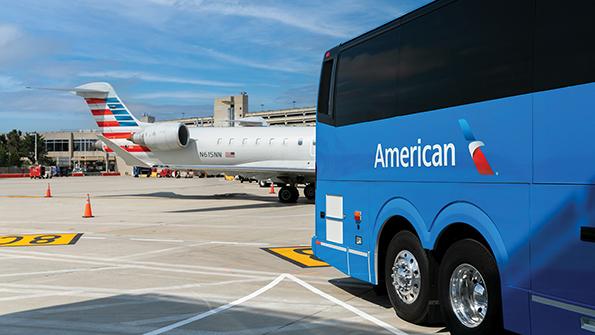How An Innovative Bus Service Is Maintaining Regional Air Connectivity

Landline buses carry passengers from smaller airports directly to American Airlines’ airside gates at Philadelphia International Airport.
As the US domestic air transport map is redrawn because of major carriers pulling capacity out of smaller markets, a company with no aircraft is offering communities losing air service a way to stay connected.
Fort Collins, Colorado-based Landline operates services with high-end motorcoaches on routes previously operated by regional aircraft. The Landline routes are conducted under capacity purchase agreements with American Airlines, Sun Country Airlines and United Airlines. The buses are included as a “flight” in airline itineraries.
The company’s top executives have decades of experience working for a variety of airlines.
Landline uses real-time traffic information to determine how best to deploy its leased fleet, while avoiding delays and cancellations.
Checked bags are transferred from the buses just as they are between aircraft. In the case of American Airlines’ Landline-contracted service connecting Philadelphia to both Allentown, Pennsylvania, and Atlantic City, New Jersey, passengers go through US Transportation Security Administration (TSA) checkpoints at the smaller airports and do not have to go through security again before boarding their flight from Philadelphia International Airport (PHL).
The bus arrives at American’s PHL gates on the airport’s airside. Landline services operated in conjunction with Sun Country–connecting four smaller midwest markets to its Minneapolis International Airport (MSP) base—and United Airlines—connecting Allentown to Newark and Fort Collins to Denver—do not have secure-to-secure transfers.

On those routes, passengers are dropped off at the arrivals area and then go through security. But they do not have to check in again.
“From beginning to end, you’re a ticketed air passenger, even though you might be riding on a motorcoach,” Sun Country SVP and chief marketing officer Brian Davis told ATW. “You have all of the protections in terms of things like misconnections that a traditional passenger would have.”
Landline services are booked by passengers when buying an itinerary from the airline just as if a regional carrier were operating the routes. The buses are designed with around 35-40 seats with 36-inch-to-40-inch pitch. A tour of an American-branded Landline bus at the recent TakeOff North America conference in Atlantic City revealed a modern interior with seats resembling premium economy seating on a US airline. Wi-Fi connectivity allows passengers to be online for work or entertainment as if they are on an airline flight.
FILLING THE PILOT GAP
The pilot shortage and other factors leading to reduced service at many smaller US airports have created a “perfect storm that Landline has come into, offering a potential way to grow service back into these communities at a much lower cost,” Nick Johnson, the company’s VP and head of revenue, told ATW. “Ultimately, even without the pilot shortage, it’s still far more efficient and economical to operate a motorcoach than it is to operate a 50-seat aircraft, even at previous pilot wages.”
Johnson previously spent eight years working in network planning and revenue management at Delta Air Lines.
“Essentially, all of our senior leadership has extensive backgrounds in commercial and operational roles at airlines, large and small,” he said. “So, when we think about our company, we don’t think of ourselves as a bus company. We’re an airline. We just happen to operate buses.”
He added that Landline’s schedules are “for the most part determined by airline network planners. It’s just another fleet type that they can schedule. So, instead of having an Embraer E175 in your scheduling software, you just have ‘BUS’ and you look at it just like you would an aircraft. [Scheduling Landline routes and frequencies are] based on principles of airline network planning.”
CEO and co-founder David Sunde and fellow co-founder Ben Munson both worked in network planning at Alaska Airlines. Sunde has called Landline services “a glimpse into the future of travel.”
Landline is not a publicly traded company and has not released earnings results, but company executives say the company is performing well and growing.
At the Takeoff North America conference, Johnson joked that many directors of small- and medium-sized airports believe Landline is the “grim reaper” seeking to take away air service. But airports are warming to the idea.
“While the thought of bus service replacing air service isn’t appealing, it’s important for airport operators to remember our responsibility of serving the community and providing connectivity to our communities,” Colin Riccobon, director of government affairs at Allentown’s Lehigh Valley International Airport (ABE), told ATW. “Landline gives regional airports that chance on short-haul routes for airports located near major hubs.”
Atlantic City International Airport (ACY) director Tim Kroll said he was approached by American Airlines regarding starting Landline service.
“We do not have a hub connection with a legacy carrier at all,” he explained. “We’ve been trying to get that for a while. We’ve had discussions with American, United and Delta in the past.”
He added: “American came to us with this opportunity and said, ‘Listen, we don’t have the ability to put aircraft jet service in there today, however we can get this Landline service in there, which provides the connection to Philadelphia, and we’re going to go secure-to-secure through TSA and make it a seamless transition for the passenger.’ So, we believe it’s a step to eventually getting aircraft service with American Airlines [to longer-haul markets] once you have the ability to prove the market.”
Johnson pointed out that many airports are left with a choice between bus service or little-to-no air service, especially flights that connect to a major hub. Startups Alevo Airlines and Breeze Airways, as well as established LCCs Allegiant Air and Spirit Airlines, have opened service at many smaller US airports since 2021. But that service is generally far less than daily and connects the airports to vacation destinations, giving passengers minimal access to the broader US airline network.
“The reality is that the economics of increased supply chain costs, airframes that are reaching their end of life, and resource allocation—where airlines are deciding to relocate pilots, block hours and aircraft into larger markets that make more sense—mean short-haul markets are generally relatively unprofitable,” he said. “So, regardless of whether Landline existed or not, a lot of network airlines have been pulling back from short-haul markets in recent years, and that will continue.”
MORE EFFICIENT
To say the least, it costs less to operate a bus than a commercial aircraft, making the service appealing as an alternative for airlines. Convincing passengers to “fly” a leg on a bus is one of the biggest challenges to attracting travelers accustomed to thinking of buses as a big step down from an aircraft, picturing crowded intercity bus service on aging motorcoaches.
“All the feedback that I’ve heard from customers who have tried the bus has been incredibly positive,” Davis said. “The buses are modern. They’re clean. They exceed expectations.”
He added it is important to make sure passengers clearly know in advance that part of their journey will be aboard a motorcoach.
Airports are also finding that passengers are accepting Landline service, seeing it as a better alternative to driving to a major hub, where parking costs and hub-security processing await. “Landline allows regional airports like ABE to provide our customers connectivity to a major hub airport, while still enjoying the convenience of starting their trip with the reduced stress of using their regional airport,” Lehigh Valley Airport’s Riccobon said. “The Landline service also helps to restore a void of serving short-haul routes that was created as the airlines transitioned away from smaller aircraft.”
Airlines also are increasingly viewing using motorcoaches on shorter routes as part of efforts to reduce carbon dioxide emissions.
“Oh my gosh, it’s significantly more efficient costwise, as well as environmentally,” Sun Country’s Davis said. “So, a much smaller environmental footprint from either operating an airplane or all of these passengers driving their own personal vehicles to the airport. The bus has a more efficient environmental footprint and economic footprint.”
He added: “The cost and environmental impact are significantly less to the point where our choice isn’t really, would we fly a plane or drive a bus? Because the plane would be so beyond the possible.”
Davis and Johnson both envision electric buses being used by Landline within the next several years. But even a diesel-powered bus is far more efficient than an aircraft, Johnson noted.
“The fuel burn on most of our missions is about 10 gallons,” Johnson said. And moving to electric buses “is not necessarily groundbreaking technology, and it’s not going to require billions of dollars and decades of investment. It’s a technology that’s here. … Our [current diesel-powered] buses, even in a super-premium 35-seat configuration, can still remove 90% to 95% of the carbon footprint of a passenger traveling from a regional airport into a hub.”
Convenience, significantly reduced costs and a much lower environmental impact all point to motorcoaches replacing aircraft on more and more short-haul routes, Johnson said. Landline first limited routes to less than 150 miles but is now open to a maximum range of up to 250 miles.
“The potential certainly exists for growth opportunities and expansion,” Riccobon said.
“We think this could be applicable to quite a large number of hub-and-spoke operations,” Johnson said. “If you kind of draw a 150-ish mile line around any major airline hub, there’s opportunity for Landline to come in and support feed into those hubs from those communities. But then there’s also opportunities to serve medium-sized cities that aren’t traditionally defined as network carrier connecting hubs.”
And Landline has ambitions beyond US borders.
“The US, obviously, is a great starter market,” Johnson said. “But other North American markets, South America, Europe—there’s a lot of opportunities for connecting hubs and spokes that don’t necessarily have optimal transportation between them today.”
